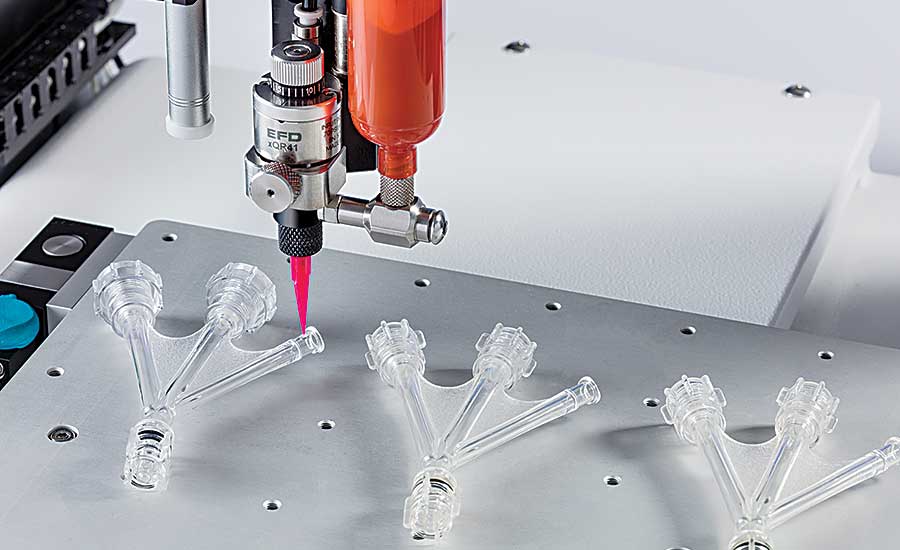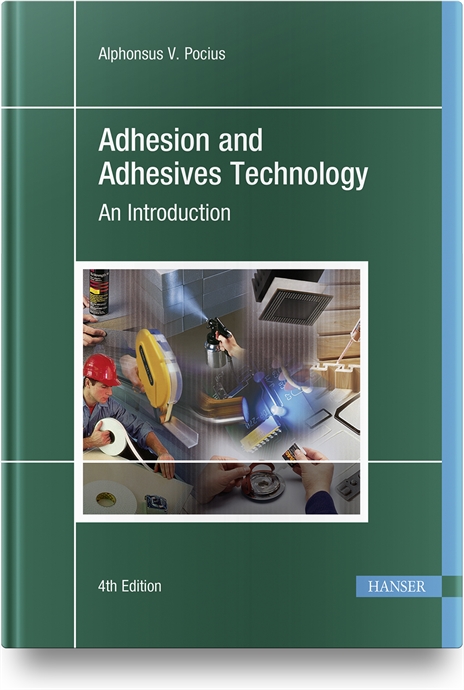If you're looking for a one-size-fits-all material, you may not have to look any further than epoxies.
Epoxies have been around since the 1950s, but they have now come into their own, due to their endless versatility and performance characteristics. Epoxies are the most widely used polymeric materials for adhesives, sealants, coatings, pottings, and encapsulations and impregnants. They come in liquids, pastes, and semi-cured films and solids, and are resistant to oil, moisture and many solvents.
They are versatile in both application and performance, with their most desirable properties being high bond strength to a wide variety of different substrates, except untreated plastics and elastomers. Their versatility lies in the fact that they can be layered with additional substances or fillers. "Epoxies are still the universal, best-cost material that you can use. [With their] flexibility, pot life and cure speed, you can do almost anything you want with them," says Dave Bongiorni, market development manager at ITW Devcon (Danvers, MA). "You can bring better properties to them a lot easier. The only thing that they can't do is bond plastic. People get very mistaken in the industry. If you could ever get them to bond plastic, you would have something in the industry that was totally unique."
Epoxies also have excellent tensile and shear strength, but poor peel strength. However, poor peel strength can be improved if the formulation is modified with a more resilient polymer or other filler.
Customizing Epoxies With Fillers
Epoxies can be modified with pigments, fillers and other resins to give a virtually endless range of viscosities, decorative effects and physical properties. Fillers are generally inorganic materials. Some inorganic materials, such as copper or silver, enable the epoxy to conduct electricity. Oxide fillers aid in heat conduction. Glass fiber fillers provide high-strength, and microballoons provide low density and thermal insulation. "You can put anything into an epoxy. You can put stainless steel or aluminum into epoxies. That's the secret. When you add a metal filler into an epoxy, it becomes like a metal. These epoxies can then be used to repair fatigued metal and can be machined or ground," says Bongiorni.
Many fillers now provide added elongation and flexibility. Plain epoxy is generally brittle. During bending, it usually gives no more than 10 degrees before breaking. But by adding urethane and acrylics, elongation and flexibility are increased. This can be very important in an assembly environment. Many assemblers want the epoxy to be as flexible as the substrates they're bonding together.
Additional fillers can also change various epoxy viscosities and cure times. "Usually 250 to 350 F is the going rate for cure service temperature," says Bongiorni. But these newer fillers boost epoxies' operating temperatures above 400 F.
Assemblers wanting to add fillers to an epoxy should forego using a one-component version. Adding fillers to a one-component epoxy might make the material too thick. However, according to Bongiorni, one-component versions can be partially filled. "Usually the heavier-filled products are the two-component versions. The one-component versions could become too thick. I don't see a lot of filled one-part systems," says Bongiorni.
Epoxy Applications
Epoxies are primarily used for bonding metals and wood in structurally demanding applications. Some bonding applications include automotive hoods and doors, aerospace composites, batteries, electrical components, paint rollers, hardware and sporting goods. Epoxies are also the most widely used plastics in the electronics industry. They are used in embedded applications, molded parts and in laminated parts for printed circuit boards. "Epoxies are used by a lot of electrical box companies as a potting compound to prevent shock vibration. And because two-component epoxies can be very flexible, that's great for potting components. The epoxy can absorb the shock and vibration, but at the same time it can be additionally modified to make it electrically conductive," says Harry Arnon, president of Hernon Manufacturing Inc. (Sanford, FL). Epoxies can also be used in prototype and short-run molds for many plastic processes.
One Component or Two-What's the Difference?
Before an assembler begins contemplating which type of epoxy to use-one component or two-he should first understand the basic difference between the two versions.
One-component epoxies can be used straight from the tube. No mixing, metering or degassing is required. However, these epoxies require heat for curing. One-component versions have an initiator, which is the heating element, contained along with the resin. The epoxy then requires an oven or other heating mechanism to reach full cure. Typical cure times are 30 to 60 minutes at 350 to 400 F. Handling strength can be achieved rapidly with induction cure. Curing time for this is usually 6 seconds at 325 to 425 F. However, heat curing must follow induction curing for the epoxy to reach full cure. Ultraviolet light-curing epoxies are also available in one-component versions.
Two-part epoxies are the most common. These epoxies require the user to mix a resin and a hardener. Hardeners trigger the polymerization required for curing. When the two are mixed, either mechanically or by hand, an exothermic reaction occurs as the molecules begin to cross-link. When a full cure is reached, the bond is essentially a hard piece of molded plastic, says Bongiorni.
Two-part versions are somewhat stronger than their one-part cousins, because of their different curing characteristics. "You have a chemical reaction going on between the resin and hardener, and they form something that is bigger than either of them by themselves," says Bongiorni. Two-component epoxies can be cured at either room temperature or elevated temperature. They can achieve handling strength in 5 minutes to 8 hours, depending on the type of curing agent used. The most commonly used epoxies solidify in 2 to 3 hours at room temperature. A catalyst can be added to speed the reaction between the resin and hardener.
However, all epoxies should be allowed to cure 5 to 7 days at room temperature before testing.
Choosing the Correct Type
Two-component epoxies allow assemblers to bond almost anything. "When you bond something with two parts, you can get a fierce chemical reaction. Therefore, you tend to have better physical properties," says Bongiorni. But over the years, one-component epoxies have been getting better.
One-component epoxies are excellent for assembly lines or areas where users would place a drop of epoxy on one part in an assembly process where two parts of an assembly are being mated together. The assembly would then travel into a heat source for its curing cycle. One-component epoxies are easier to use in an original equipment manufacturer operation, because no mixing is involved. With metering and mixing eliminated, rejects can be lower due to incorrect hardener and resin ratios. Arnon agrees. "The perfect example would be a company that we dealt with a while ago. It was using a two-component epoxy to bond painted components. The painted components would then go through an oven to cure the paint. After viewing the process, we changed the company's two-component epoxy to a one-component version. Because the assembly process already included an oven-curing stage for the paint, the heating process cures the epoxy simultaneously. This enabled the company to eliminate mixing the two components together. By eliminating the mixing, you are also eliminating the mixing equipment and problems with incorrect ratios. The company also eliminated pot life problems," says Arnon.
According to Arnon, in the end, choosing one over the other is going to depend on the specific application. "The advantage with the single-component epoxy is that you don't have to mix it. If you put it in a dispensing machine, you don't have to flush it. But the disadvantage is that you need heat to cure it. The advantage of the two-component epoxy is that it can cure at room temperature, so you don't need heat. But the disadvantage is that you have to mix it. So if you have a part that later on goes through heat for another application, you might want to use a one-component epoxy if you can. That way, you'll eliminate mixing time and equipment purchases," concludes Arnon.







